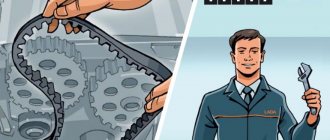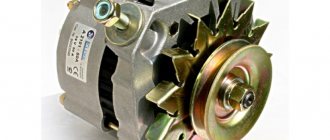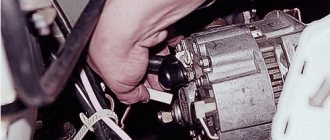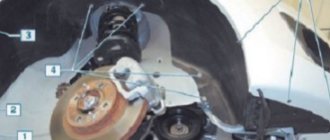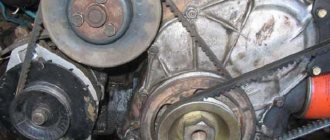The choice of a new belt for auxiliary units, its removal, as well as the dismantling of the generator on a car such as the Lada Largus largely depends on the configuration.
Therefore, you first need to understand which version of the domestic station wagon we are talking about specifically in your case, and then choose the appropriate algorithm of actions.
Considering the difference between generator belts, as well as the different approaches to removing and installing generating devices, there will not be universal instructions for all occasions. Each situation must be considered separately.
What is the service life of the standard alternator belt on Lada Largus?
The alternator belt is a consumable item that must be replaced periodically. This is true not only for the Lada Largus, but also for all other cars with such a component in the engine compartment. The only difference is that the belts themselves have some differences, and can also serve for different periods of time.
AvtoVAZ, acting as the manufacturer of the Lada Largus, advises not to rely on whether the car has an 8 or 16 valve engine. It's better to rely on the package. Regarding the replacement of the drive belt of auxiliary units, AvtoVAZ gives the following recommendations on timing, depending on the equipment:
There is power steering, but no air conditioning. In this case, the interval between replacements should be 4 years or 60 thousand kilometers traveled. Whichever comes first.
There is power steering and air conditioning. Oddly enough, in this case the life of the belt increases to 120 thousand kilometers.
We must not forget that the belt may wear out ahead of time. Here, focus on the current state of the consumable. If you hear a characteristic whistle, and defects, cracks and tears are visible on the surface of the belt, then in this case the consumable must be replaced. Even if very little has passed since its installation. There is either a problem with the quality of the installed part, or the operating rules have been violated; there are factors that influence accelerated wear of the belt. They need to be found and eliminated so that the same thing does not happen to the new belt.
Other disadvantages of the model
The gasoline consumption of the Lada Largus is higher than that of the Kalina station wagon by 1.5 liters, with a weight difference of only 80 kg. Engine vibration occurs as soon as the tachometer needle reaches 1500 rpm. The rpm often jumps or drops to 500. When driving at a speed of more than 90 km/h, the ears begin to pop, like in an airplane during takeoff. This upsets many car enthusiasts, because at these moments they want to stop the trip and get out of the car.
The lack of rear mudguards is a big drawback of the presented model. Ball joints pressed into the arms will make it difficult to repair the suspension in the future. The gap between the fender and the front bumper must be covered with some kind of gasket to maintain cleanliness. Dirt constantly accumulates in this area.
Limited functionality as standard - no ABC or front windows. During rainy weather, the windows constantly fog up; in this case, they need special treatment. In winter, the accelerator pedal freezes, the interior warms up very slowly, and the engine cools down quickly. Pump malfunctions occur when the car's mileage is more than 30,000 km; there are no floor mats in the cabin.
Sources
- https://www.dvigokcomtrans.ru/avto/vaz/vaz_largus/
- https://lada-avtovaz.ru/remont-generatora-na-lada-granta/
- https://expertvaz.ru/lada-largus/problemy-minusy-nedostatki.html
This is interesting: DIY armrest on Lada Largus
Which belt to use
AvtoVAZ and Renault have made life somewhat more difficult for car owners. After all, there is not one universal belt. The choice depends on the engine, as well as on the power steering and air conditioning. That is, from their presence or absence.
To help you make your choice so that you can finally start replacing the alternator belt on your Largus, listen to the following recommendations.
- Without air conditioning and power steering with an 8-valve engine. In this case, a four-ribbed belt of the 4PK715 series will be required.
- Without air conditioning and power steering with K7M engine. Here look for a five-ribbed belt 5РК, the length of which is 1110 mm.
- With power steering, but without air conditioning and with a K4M engine. This is a 16 valve engine. Here you need a 6RK six-ribbed poly V-belt with a length of 1200 mm.
- With power steering and air conditioning and an 8 and 16 valve engine. A 6-strand element 6РК is again required, but with a length of 1820 mm.
- Without power steering, but with air conditioning and an 8-valve internal combustion engine. In this situation, a 6-ribbed 6RK belt is also used, but its length should be 837 mm.
As you can see, installing a new alternator drive belt on Largus cars with 8 or 16 valve engines is not as difficult as the process of selecting the appropriate spare part itself.
Although in practice everything is not so difficult. It will not be difficult for you to determine what kind of engine is under the hood, and also remember whether you have power steering and air conditioning.
What's worth knowing?
The generator brushes are the key elements that ensure the removal of current from the stator and its transmission to the rotor commutator (armature). After starting the engine, the parts take on the greatest load, which leads to their rapid wear. The Renault Logan generator brushes are made of graphite, which is why they are commonly called “carbon”. Their scope of application is not only car generators, but also other mechanisms - machine tools, urban transport and others.
When choosing replacement parts, it is recommended to give preference to original spare parts. One of the brush options is the product with RENAULT catalog number 6001547553.
The peculiarity of the mentioned brand of brushes is their versatility, because they can be installed on vehicles of different years of manufacture. This is due to standard characteristics, long service life and other advantages.
If you know certain principles, replacing worn generator brushes does not cause problems. The main thing is to prepare the tool in advance and purchase replacement parts.
In some cases, parts are made to order, so you may have to wait a while.
Replacing the belt on Largus
Removal, as well as installation of a new alternator belt in the case of such a car on the Lada Largus, equipped with an 8 or 16 valve engine, must be carried out according to the instructions. No amateur activities, as this can lead to serious and unpleasant consequences.
First, dismantling is carried out, then a new part is installed, after which tensioning is performed. You only need to tighten the belt if the configuration does not include an automatic tensioner. And this one is available in a version with air conditioning and power steering at the same time.
As for replacement, the algorithm is as follows:
- remove the dirt protection panel on the right side of the engine;
- take a socket wrench or a 13mm socket;
- grab the tensioner bolt and rotate clockwise;
- rotate until the hole in the bracket aligns with the recess in the body;
- hold the key in this position and insert a metal rod with a diameter of about 6 mm into the aligned holes (you can take a hex key of the appropriate size);
- fix the tensioner in this way;
- now there is no tension on the belt, and it can be easily removed;
- At the same time, check the condition of the support and tension rollers;
- Next, arm yourself with a new suitable belt;
- put it on the units, observing a certain sequence;
- lay the belt over the pulleys and then slide it under the tension roller;
- Finally, the belt should be placed under the support roller;
- remove the clamp inserted into the holes;
- Now the tensioner just has to put the load on the new belt;
- Using a 18mm wrench, turn the crankshaft several times;
- make sure the belt is installed correctly;
- Replace the mudguard.
If the equipment does not include an air conditioner, then during dismantling you will need to turn the tension bolt counterclockwise. This will release the tension and allow the worn element to be removed.
Pay attention to how many rivulets there are on the pulleys and on the belt itself. If the pulleys have 6 grooves, and the belt itself goes on 5, then the installation must be done by placing the belt closer to the outer edges on all pulleys. At the same time, the internal stream will remain free.
HE IS GOGA, HE IS GOSH
When replacing spark plugs on a K4M sixteen-valve engine, the main thing is not to drop the fasteners of the individual ignition coils: the bolt easily slides off the head and disappears into the abyss between the intake manifold and the valve cover. If you don’t catch it, it can later cause trouble by shorting out electrical circuits or rubbing holes in the plastic manifold. Therefore, it is better to use a magnetic head or, at worst, attach a powerful magnet to the extension cord. Such a useful household item can be obtained, for example, by gutting an unnecessary computer hard drive.
It is easier to change the oil in an eight-valve unit: if you remove the exhaust manifold protective cover by unscrewing three nuts, you can hook onto the filter housing from under the hood. And even a chain puller. But it is advisable to purchase an original cup puller - it is relatively inexpensive, and it is much more convenient to work with (and you don’t have to remove the casing). The drain plug is for an 8 square socket, have this key ready in advance. Access to the plug is possible through the slots in the standard protection of the engine compartment.
Replacing the coolant is no easier, since the system does not have drain plugs. There is nothing left to do but remove the lower radiator pipe, risking getting burned by hot liquid (there is more escape when it is hot) or inhaling toxic fumes (from the trough they “smell” much more strongly than from the narrow neck - but how to get into it?) . To compensate, there are fittings to remove air from the filled system, but this is little consolation.
Drive belt tightening for Lada Largus
The installation diagram and location of the generator belt suggests that the Largus system automatically, that is, independently, tensions the element. This means that no additional interventions or manipulations are required.
This only applies to trim levels with air conditioning and power steering. You really don't have to do anything here.
If you have a different configuration, then you will still have to tighten the alternator belt yourself.
But first you need to understand that the part generally needs tightening. In general, to check the tension, the official instruction manual states the need to use a strain gauge tester. The only problem is that such equipment is available only at dealerships. There is absolutely no point in looking for and buying it for personal use. Here you can resort to another method. Namely:
- remove the mudguard from the engine;
- move under the car, which needs to be hung on a lift or placed over a hole;
- press on the lower branch of the belt so that it bends by 7-8 mm;
- if the belt moves easily, the tension is weak;
- loosen the 2 bolts securing the tension element bracket;
- turn the adjustment screw counterclockwise;
- achieve the desired tension level;
- tighten previously loosened bolts;
- Try not to tighten the part too much, as this will cause it to fail prematurely.
This completes the tightening. Check the result of the work done in action.
When to change?
During scheduled maintenance, attention is usually paid to other issues - the condition of the engine oil, replacing consumables and solving other problems. Many people forget about the need to check brushes. For this reason, the wear of this part often comes as a surprise to the car owner, and the signs of a malfunction are completely confusing.
According to the workshop technicians, the frequency of brush replacement is on average 50,000 km. It is recommended to periodically inspect them and ensure the normal functionality of the product. This will avoid problems with the operation of the car. It is important that to check the part there is no need to remove the generator and carry out complex work.
If the car owner has not paid due attention to the condition of the brushes, the following symptoms will help remind you of a possible problem:
- A decrease in voltage in the on-board network, which can cause failure or incorrect operation of the equipment.
- Deterioration of illumination of the vehicle interior, as well as problems in the operation of head light sources (the brightness of their glow decreases).
- Independent shutdown of elements of Logan's electrical equipment for no apparent reason.
- Rapid discharge of the vehicle battery, which subsequently causes serious problems with its charge.
Removing and replacing the generator
Removal of the generator, with or without air conditioning, is required only in case of repair or replacement of the generating device on the Lada Largus model. It is better not to do this unless absolutely necessary.
In this case, you can remove the generator in different ways. This directly depends on the configuration in which the Lada Largus is presented.
The options may be the following, which affect the dismantling and installation scheme:
- K7M engine without power steering and air conditioning;
- K7M engine with power steering, but without air conditioning;
- with power steering and air conditioning;
- K4M engine without air conditioning, but with power steering.
But regardless of the configuration and equipment, before removing the generating device on all versions, you need to do the following:
- install the machine on a lift with a lifting capacity of at least 3.2 tons;
- turn on the handbrake;
- turn off the ignition;
- lift and securely secure the hood;
- disconnect the negative terminal from the battery.
Now each situation must be considered separately. This will clearly allow you to understand exactly how to remove and replace the generating device.
K7M engine without air conditioning and power steering
With this variation of equipment, the dismantling and replacement procedure is as follows:
- remove the front right wheel;
- remove the engine splash guard on the right side;
- remove the front arch skin from the right front wheel;
- remove the protective cap from the nut;
- disconnect the wiring harness from the generator;
- using a 13mm socket, unscrew this nut under the cap;
- disconnect the wire lugs from the existing B+ terminal on the generator;
- cut the old belt and remove it, since it is still not suitable for reuse;
- Using a 10mm socket, unscrew the mounting bolts from the bottom and top that hold the generator to the bracket;
- remove the problem unit;
- replace the tension and support rollers;
- secure the new drive belt;
- tighten the mounting bolts;
- for the bolt fixing the generator to the bracket, use a torque of 21 Nm;
- for wire fastening nut 14 Nm.
At this point the replacement can be considered complete. Check the node for correct operation. If everything works correctly, then complete the full assembly.
K7M engine without air conditioning, but with power steering
Here the instructions will look like this:
- remove the protective cap from the nut, disconnect the wiring harness and unscrew the nut itself with a 13mm head;
- disconnect the wire lugs from the generator terminal B+;
- Unscrew the adjustment bolt and the upper bolt securing the adjustment bar approximately 3-4 turns using a 10mm socket;
- dismantle the front right wheel, remove the mudguard and arch casing;
- taking the head at 10, make 3-4 turns of the lower bolt securing the bar to loosen the belt tension;
- remove the belt itself;
- Using the same head, unscrew the lower mounting bolts that hold the generator on the bracket;
- unscrew the upper bolt connecting to the bracket;
- remove the generating device from the machine;
- reassemble in reverse order;
- for attaching the generator bolt to the bracket, use a torque of 21 Nm;
- for the tension roller adjustment bar mounting bolt, also 21 Nm;
- the generator wire connection nut requires a torque of 14 Nm.
In addition to replacing the belt, you will also need to install a new tension pulley.
Equipment with air conditioning and power steering
This is quite a good package, since here the driver can count not only on easier rotation of the steering wheel due to the hydraulic booster, but also on comfortable conditions in the cabin created by climate control equipment.
As for replacing the generator, the procedure is as follows:
- remove the front right wheel;
- remove the front bumper;
- using a 16mm spanner, turn the tension roller clockwise;
- lock the tension roller using a 6 mm hexagon;
- remove the drive belt;
- unscrew the air deflector fastenings and then remove the reflector itself;
- Using a 10mm socket, remove the upper mounting bolts of the radiator bracket to the body;
- remove the brackets;
- remove the cooling radiator together with the air conditioner condenser from the lower mounts;
- to do this, carefully move it towards the left wing;
- Using a 13mm wrench, unscrew the fastening nut of the generator wire and remove the wire;
- disconnect the wiring harness from the generator;
- taking the head 10, unscrew the fastening bolt that holds the generating device;
- use the same head to unscrew the lower fastening and remove the generator from the car;
- perform assembly with a new device in the reverse order;
- tighten the bolt securing the generator to the bracket to a torque of 21 Nm;
- the wire fastening nut requires a torque of 14 Nm.
This is not to say that the procedure is easy. Some people are scared by the fact that it is necessary to remove the front bumper and radiator. Yes, here the scheme turned out to be not the most convenient. Although in reality, almost every Lada Largus owner, having theoretical knowledge and at least a little practical experience, will be able to cope with the task.
If you are afraid to take risks or are not confident in your own abilities, then it is better to send your Lada Largus to a specialist car service center.
K4M engine without air conditioning, but with power steering
In the case of this configuration of the domestic Lada Largus station wagon you will need:
- remove the front wheel on the right side, remove the mudguard and remove the alternator belt;
- unscrew the nuts securing the fuel rail protection, and then remove the protection;
- disconnect the fitting from the fuel rail pipe;
- Using a 13mm wrench, unscrew the nut securing the generator wire and remove the wire itself;
- disconnect the wiring harness connector;
- take the wiring aside;
- Using a 13mm head, unscrew the power steering tube mounting bolt on the cylinder block;
- Use a 10mm head to unscrew the bolt that secures the bracket for fixing the power steering pipeline to the generator;
- remove the bracket;
- unscrew the upper mounting bolt of the generator using a 10mm socket;
- Using the same head, unscrew the lower mounting bolt;
- remove the generator upwards along with the lower fixation bolt;
- perform assembly in reverse order;
- for the bolt securing the generating device to the bracket, apply a torque of 21 Nm;
- a torque of 22 Nm goes to the bolt securing the power steering pipeline bracket to the generating device;
- tighten the generator wire fastening nut to 14 Nm;
- fuel rail protection nut also with a force of 21 Nm;
- install a new belt;
- complete the assembly of all dismantled elements.
Finally the work is completed.
Disadvantages of modern cars
Expensive repairs of modern cars force you to spend a considerable amount of money, despite careful driving and proper maintenance. Even a small dent repair costs at least 2,000 rubles. Cash injections increase not only in the process of engineering corrections, but also protective measures, such as purchasing a garage and paying for utilities for the use of light in it, installing an alarm system, and paying for parking spaces. There is also a waste of money on various accessories for your car.
- a flaw that cannot be eliminated when it is not possible to eliminate it in the usual way;
- a drawback that requires huge expenditures of money and time to eliminate, when the time spent on repairs is disproportionately spent and a huge price that corresponds to the cost of the car itself;
- a defect identified for the second time, when cases of detection of disadvantages are repeated constantly and do not make it possible to operate the vehicle.
The internal combustion engine does not start when the starter is working
If in the ignition key position “Engine Start” the starter turns, but the engine does not start, it is necessary to find out the functionality of a number of elements.
| Diagnostics | Malfunction | Elimination procedure |
| The rotation of the internal combustion engine occurs more slowly than usual, and there are extraneous sounds in the engine compartment. | At low temperatures, engine oil may solidify. Wedging of engine attachments - water pump, generator. Destruction of the connecting rod and piston group elements - scuffing on the liners or cylinders. | Park the car in a warm place to allow the oil to warm up. Poor quality oil - replace. |
| Replace the generator/water pump or eliminate any jamming. | ||
| Repair the internal combustion engine. | ||
| Fuel tank arrow in empty position | Running out of fuel | Refuel the car |
| When the key is turned to the “ignition” position, the fuel pump is not heard to operate. | There is no power supply to the pump. | Remove the fuel pump, apply voltage to the terminals; if the pump works, check the power supply circuit (fuse, relay, wiring), as well as the security alarm. |
| The pump has failed. | Replace the inoperative pump with a new one. | |
| The engine can be started with the gas pedal pressed; after releasing it, the engine stalls. | The idle speed control sensor is faulty. | Install a new sensor |
| The engine tries to start jerkily, popping sounds are heard in the exhaust system, high vibration | There is no spark, sparking occurs at the wrong time. | Check for spark. Check the correct connection of high-voltage wires or ignition coils according to the electrical diagram. |
| Check the crankshaft position sensor and replace if necessary. | ||
| Insufficient pressure in the fuel rail. | Fuel pump wear. | Replace the pump. |
| Clogged fuel filter. | Replace the filter. | |
| Damaged fuel line. | Inspect the fuel line for kinks and other damage. | |
| During the cold season, water in the fuel system may freeze. | Heat the frozen line to above-zero temperature. | |
| Fuel injectors do not deliver gasoline | Faulty injector, problems in the electrical circuit. | Measure the injector resistance, it should be 12 ohms. Replace the faulty injector. |
| Check electrical wiring. | ||
| Engine control unit does not work | There is no 12V power supply to the ECU. | Check the power supply to the control unit. |
| ECU failure | Replace block. | |
| Air leak in the intake manifold. | Damage to the intake manifold. | Replace or repair the collector. |
| Damage to vacuum hoses. | Replace hoses or tighten clamps. | |
| Violation of the tightness of the intake tract | Change the intake manifold gaskets. |
After this, check that all marks on the belt, rollers and pulleys match. A broken timing belt can be checked in a simpler and faster way. Unscrew the oil filler cap on the engine, make sure that when you try to start the internal combustion engine, the camshaft rotates, part of it is visible under the cap.
Official figures
The AvtoVAZ company does not rule out that its 89th engine will be “fed” with 92nd gasoline. This option is officially allowed. But for the K4M engine only AI-95 gasoline is suitable, also A-95 or better.
Speed characteristics:
- 8-class: 14.2 s, 158 km/h
- 16-class: 13.1 s, 165 km/h
The acceleration time from zero to 100 km/h is indicated here.
Be aware that different engines on Largus are equipped with different gearboxes. In the first case (8 cells), the gear ratio of the main pair is 4.5. In the second - 4.2! We have already written about changing the oil in them here.
In general, Largus with an 8-valve engine is a family car, not intended for high-speed travel. Acceleration from scratch on it is very brisk, but this is due to the increased gear ratio. Thanks to him, from about 130 km/h the dynamics disappear completely.
The VAZ company promises us better efficiency with the K4M engine, and not with the 11189. The numbers do not differ much, but they are in the region of 8 liters per hundred.
Unpleasant features of the Lada Largus
By 3000 km, problems arise with the generator, and a hum appears in the engine. The reason for this disadvantage may be weak belt tension. It needs adjustment and, possibly, replacement of the generator rollers and bearings. The camshaft and crankshaft seals may wear out, reverse sensors may fail, ball joints may knock, the front wheel bearings may need to be replaced, or many other problems may arise that are aesthetic in nature or affect passenger comfort.
The second row of seats has seat belt buckles sticking out of the cushion recesses; the passenger is forced to sit on them, which is not very comfortable. The passenger of the second row, whose seat is located in the middle, is forced to use seat belts, the fastening of which is located on the ceiling of the cabin. The gearshift lever is located next to the center console switches, which in itself causes major shifting problems.
The quality of painting leaves much to be desired; in some places, when pressing on the surface, the paint begins to peel off. This problem occurs at the top of the doorways, at the point where they are attached to the body from the inside, under the hood. When using first and second gears, a knock is heard from the bottom; most likely, this is the knocking of the muffler, which after a few thousand kilometers begins to rust.
Problems with the starter, ways to solve them on Lada Largus
It is customary to divide breakdowns into electrical and mechanical based on the nature of their origin.
Electrical
The most common type of failure. The section of electrical wiring from the steering column to the starter must be inspected.
Signs:
- Slow rotation of the rotor;
- The control unit does not respond when current is applied;
- The starter clicks but does not turn. Most likely there is an interturn short circuit, a broken wiring, or a faulty solenoid relay;
- Wear of armature, brushes.
To make diagnostics as productive as possible, rule out the following breakdowns. To do this you need to check:
- presence of charge in the battery;
- tightness of battery terminals;
- wiring integrity. First of all, we inspect the area from the steering column to the control panel, and then the remaining areas;
- serviceability of the ignition switch. Backlash, poor contact, and delays in turning are unacceptable.
Mechanical
A stationary crankshaft with a working starter is a sign of a malfunction of the overrunning clutch, pressure spring, wear of the retaining ring, or flywheel. A metallic grinding noise during rotation indicates wear on the flywheel teeth and possible breaks. If the starter does not start, then the reason is a faulty electrical part.
After starting the motor, the launcher continues to rotate:
- jamming of the spring, drive shaft;
- contact board sticking;
- wear of the solenoid relay;
- The bearing race is damaged.

